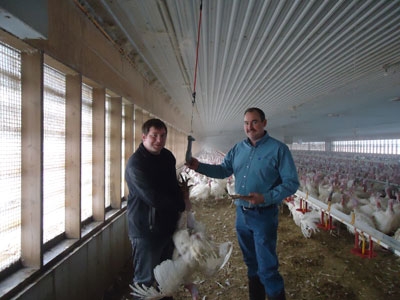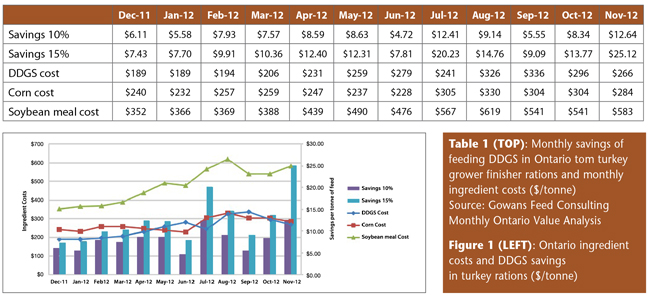
DDGS Cost Savings
By Neil Campbell Gowans Feed Consulting
Features Nutrition and Feed Research Canada Poultry Research ResearchCanadian feeding trial demonstrates benefits of elevating inclusion rates of DDGS in commercial tom turkeys
 Tyson Schlegel (left) of Great Lakes Poultry Farms Ltd. and Neil Campbell from Gowans Feed Consulting conducted a Canadian trial on Dried Distillers Grains with Solubles (DDGS) in turkey rations.
Tyson Schlegel (left) of Great Lakes Poultry Farms Ltd. and Neil Campbell from Gowans Feed Consulting conducted a Canadian trial on Dried Distillers Grains with Solubles (DDGS) in turkey rations. A recent Canadian on-farm feeding trial demonstrated significant feed cost savings while maintaining live animal performance through the inclusion of Dried Distillers Grains with Solubles (DDGS) in properly balanced turkey rations. The trial, conducted by Gowans Feed Consulting in conjunction with Great Lakes Poultry Farms Ltd., Fischer Feeds, and the U.S. Grains Council, tested DDGS inclusion rates of nine per cent and 15 per cent.
Turkey producers can therefore proceed with confidence with DDGS inclusion rates of up to 15 per cent, provided that rations are correctly balanced. The exact feed cost savings achieved by producers will depend on the price of DDGS versus the price of other grains and proteins, but may be significant.
Feed Cost Savings
DDGS from corn are a co-product of the U.S. and Canadian ethanol and distillery industries and are widely available across Canada. During most times of the year, they represent a significant opportunity to reduce feed costs.
DDGS are a moderate energy and amino acid ingredient, a good source of available phosphorus and highly palatable. Feeding trials in the United States have demonstrated inclusion rates of up to 20 per cent in tom turkeys without any detrimental impact.
In Canada, turkey producers and nutritionists have been cautious in increasing inclusion rates past 10 per cent for fear of reducing growth performance and increasing wet litter challenges. However, our recent trial demonstrates that DDGS inclusion rates can be safely increased.
Over the last several years, customers of Gowans Feed Consulting have been successfully feeding DDGS at inclusion rates of 10 per cent in the grower and finisher stages of tom turkey rations but were aware of the notion of realizing significant feed cost savings opportunities by increasing the inclusion rates. Table 1 and Figure 1 present the theoretical monthly feed cost savings of feeding DDGS in tom turkey grower finisher rations at 10 per cent and 15 per cent in southwestern Ontario over diets made without DDGS and the cost of DDGS relative to corn and soybean meal. Over the past year, savings at 10 per cent inclusion have ranged from $4.72 to $12.64 per tonne of feed while savings at 15 per cent have ranged from $7.43 to $25.12 per tonne of feed. Feed cost savings are at their highest when DDGS are at a discount to corn and soybean meal prices are over $550 per tonne.

The Feeding Trial
In order to gain confidence and demonstrate these potential savings, a commercial scale feeding evaluation was required. Great Lakes Poultry Farms Ltd., a large modern turkey production complex near Wingham, Ont., had four commercial grow-out barns available and is in close proximity to the Fischer Feeds feed mill, a large-scale fully automated modern facility in Listowel, Ont., with the process control necessary for the trial. The U.S. Grains Council provided funding support for the demonstration. The trial was conducted at Great Lakes Poultry Farms’ Wingham West facility from January through May 2012.
On Jan. 3, 2012, a first allocation of 16,356 commercial tom turkeys (200 Nicholas, 16,156 Hybrid Converter) was placed randomly in one barn. On Feb. 9 and 10, 2012, a second allocation of 16,175 toms (475 Nicholas and 15,700 Hybrid Converter) was placed randomly in another barn. All birds on each placement date were grown together and the same feeding program was used.
At six weeks of age, the Jan. 3, 2012, placement was weighed and split evenly between Barns 6 and 7 at the Wingham West grower-finisher commercial turkey barns. At six weeks of age, the Feb. 9 and 10 toms were weighed and split evenly between barns 8 and 9 at Wingham West. Barns 6 and 8 were fed diets containing nine per cent corn DDGS. Barns 7 and 9 were fed diets containing 15 per cent corn DDGS. All diets were formulated to the same nutrient specifications and fed ad libitum. Fifty birds from each barn were weighed weekly to monitor the average daily gain. Feed rations (pelleted) were manufactured at Fischer Feeds. Turkeys were marketed as per the standard protocol to Cold Springs Farm Processing Plant in Thamesford, Ont.
All four barns performed well on their respective treatments, with market weights, growth rate, feed conversion, mortality and feed cost per kilogram of gain achieving their respective targets.
Both treatments performed similarly with the 15 per cent DDGS treatment coming out slightly better in weight gain and with a lower feed cost at 115.5 days. Overall, the feeding trial demonstrated that there were no negative effects of increasing the DDGS inclusion rate. This should give turkey producers and nutritionists the confidence to increase inclusion rates to 15 per cent.
Neil Campbell is a partner with Gowans Feed Consulting, a leading independent poultry and swine nutrition consulting company working for producers across Canada and in select international markets. Neil is responsible for business development and consulting on feed cost reduction and ingredient price risk management for clients. More information on this feeding demonstration can be requested through Neil by e-mail at neil@gowansfeedconsulting.ca or by telephone at 519-866-5927.
Print this page